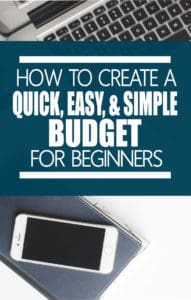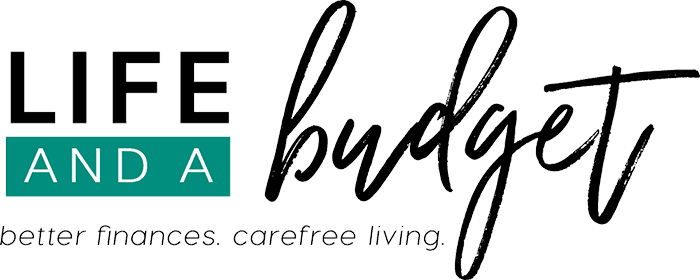Today I want to share with you a quick, easy, and simple budget.
There is an abundance of information out there for people who want to learn how to budget. I know this for a fact because I’ve been one of those folks searching for it at several points in my life. Most of the information is really good; however, I had a hard time following through on many of the things in these articles because it’s too much for my brain to process.
I’m not an organized person by nature. I can create order through much trial and error, but I’ve never been the girl who wrote with a different color pen or in different notebooks for every class. I’ll put all of that stuff in one place and when it’s time to look at it, I’ll know exactly where to find it.
So when I see articles that list a bunch of different expense categories in an excel spreadsheet, my heart speeds up and I break out in sweats. The thought of trying to manage my money in that fashion intimidates me and I’ve found that for someone who doesn’t budget at all and wants to start budgeting — it’s intimidating to them too! This intimidation makes them continue on a financially devastating path all because they are overwhelmed with what many would consider budgeting basics.
A great tool to learn how to successfully budget is the LAAB Budget Binder.

Well, you newbies — I’m going to come through for you and give you one of my most simple and practical methods of budgeting. This is just a beginning budget to help you get on track with your finances. Once you have this process down, you’ll easily be able to work from there and determine short-term and long-term savings goals and how to work your way out of debt.
When working with this way of budgeting, there are three basic questions that need to be answered. What is your income? What are your expenses? What are your plans?
“What is your income?”
Let’s start with the first question, “What is your income?”
You need to figure out your net income — not your gross. Plenty of folks out here making $54,000 in salary and trying to live a $54,000 a year lifestyle on a $46,000 net income. They are bringing home $46,000 and neglecting the fact they have insurance, any elected deductions, and taxes. This is very important to know because if your expenses equal $54,000 a year, this means you are going $8,000 in debt every year.
“What are your expenses?”
The second question, “What are your expenses?”
We just established that you don’t need to have $54,000 in expenses if that isn’t what you net. You need to consider all of your basic needs: shelter, water, power/electricity/gas, food, transportation, car insurance, car taxes, etc. Everyone has different needs. If you’re near public transit and use this rather than owning a car, you wouldn’t be paying for car insurance or car taxes.
Next, you would calculate all of your wants: cable, beauty, subscriptions, cell phone plans, etc. These are not necessities folks. Of course, if you don’t have a regular old school landline, cell phones may fall into a necessity, but I’m sure it’s not a necessity to have an iPhone and the plan to match it. These types of things are totally optional and not necessary for daily survival.
“What are your plans?”
Third question, “What are your plans?”
This is another list that includes wants and needs. For example, we all need an emergency fund so this would be included. Other things to include in your plans would be that dream of going to Tahiti, a new camera, etc. For the needs, you may consider adding a car maintenance fund, car replacement fund, and/or debt freedom.
Now, taking all of this in consideration, you would create your quick, easy, and simple budget. Add up all of your income and subtract your expenses (include the wants for now). Two things can happen: you either end up with a positive number or a negative number.
If you end up with a negative number, you need to do the following:
- Go through your expense list and add a (W) for wants and (N) for needs.
- Paying attention to the (W) items, start slashing any optional items and pay attention to the amount it will save you per month. For example, cable costs $130.
- That $130 you just slashed from your budget needs to give you a positive number after adding up all your expenses and subtracting from income.
- If it doesn’t keep slashing until you get a positive number. You want to slash until you’re able to meet all of your needs (N) without having a negative balance.
If you end up with a positive number, do the following:
- Give yourself a round of applause.
- Look at your plans list and determine how to make this surplus work for you. If you are already saving (which I hope you are) you can boost already existing savings goals. If not, determine a percentage to contribute to your plans that are a need (N) first!
- For example, if you have no savings — start with building an emergency fund or car maintenance fund. Decide a percentage of this amount to contribute to one or both of these funds. The remaining amount should go to another need.
- Other needs may be insurance premiums, car insurance premiums, etc. Once all the (N) plans become funded you will be able to concentrate on those (W) plans.
A trip to Tahiti will be well deserved and earned if you have met all of your other savings goals and met all of your necessary expenses. Saving for a trip wouldn’t be much fun if you’ve neglected car maintenance and an unexpected car repair sends you into debt.
This is one of the most basic budgets I’ve used, and to some degree, it’s what I still use today. Considering we have debt, we don’t have a vacation fund because we aren’t planning to take any trips soon when we can increase our debt repayment. Many of those long-term wants are written down on paper waiting on the day that our needs and income balance out in our favor.
Some points to remember:
If you have a surplus, look back at your expenses and still seek opportunities to slash things you don’t need or could do without for the moment. Examples are excessive entertainment, a dining out budget that is spiraling out of control, car washes, magazines, warranties, clothing, etc. This will help accelerate your savings!
A budget should be balanced. It may not meet all of your wants, but your needs and savings should be met without you going further into debt. Determine a savings’ ratio that will work for you and help you achieve short and long term needs first before focusing on any extras.
Budgets don’t have to be extreme and include every expense under the sun; however, it will give you a basic plan for what to do with your money every month.

